Moran M.J., Shapiro H.N. Fundamentals of Engineering Thermodynamics
Подождите немного. Документ загружается.


In this chapter, we have considered property relations for a broad
range of substances in tabular, graphical, and equation form.
Primary emphasis has been placed on the use of tabular data,
but computer retrieval also has been considered.
A key aspect of thermodynamic analysis is fixing states. This
is guided by the state principle for pure, simple compressible
systems, which indicates that the intensive state is fixed by the
values of any two independent, intensive properties.
Another important aspect of thermodynamic analysis is locat-
ing principal states of processes on appropriate diagrams: p–y,
T–y, and p–T diagrams. The skills of fixing states and using prop-
erty diagrams are particularly important when solving problems
involving the energy balance.
The ideal gas model is introduced in the second part of this
chapter, using the compressibility factor as a point of departure.
This arrangement emphasizes the limitations of the ideal gas
model. When it is appropriate to use the ideal gas model, we
stress that specific heats generally vary with temperature, and
feature the use of the ideal gas tables in problem solving.
The following checklist provides a study guide for this chap-
ter. When your study of the text and end-of-chapter exercises has
been completed you should be able to
c
write out the meanings of the terms listed in the margins
throughout the chapter and understand each of the related
concepts. The subset of key concepts listed on the next page
is particularly important in subsequent chapters.
c
retrieve property data from Tables A-1 through A-23, using the
state principle to fix states and linear interpolation when
required.
c
sketch T–y, p–y, and p–T diagrams, and locate principal states
on such diagrams.
c CHAPTER SUMMARY AND STUDY GUIDE
(b) For n 5 k, substituting Eqs. (a) and (c) into Eq. (b) gives
Q
m
5
R
1
T
2
2 T
1
2
1
2
k
1
R
1
T
2
2 T
1
2
k
2
1
5 0
That is, no heat transfer occurs in the polytropic process of an ideal gas for
which n 5 k.
➊ The states visited in a polytropic compression process are shown by the curve on the accompanying p–y
diagram. The magnitude of the work per unit of mass is represented by the shaded area below the curve.
Using Eq. (a), the work is then
W
m
5
R1T
2
2 T
1
2
1 2 n
5 a
1.986 Bt
u
28.97 lb ? 8R
ba
7688R 2 5308R
1 2 1.3
b5254.39 Btu
/
lb
At 708F, Table A-20E gives k 5 1.401 and c
y
5 0.171 Btu/lb ? 8R. Alternatively, c
y
can be found using Eq. 3.47b,
as follows:
c
y
5
R
k 2 1
(c)
5
11.986
/
28.972 Btu
/
lb ? 8R
11.401 2 12
5 0.171
Bt
u
lb ? 8R
Substituting values into Eq. (b), we get
Q
m
5254.39
Bt
u
lb
1 a0.171
Btu
lb ? 8R
b17688R 2 5308R2
For n 5 k, evaluate the temperature at the final state, in 8R
and 8F. Ans. 8408R(3808F)
Ability to…
❑
evaluate work using Eq. 2.17.
❑
apply the energy balance
using the ideal gas model.
❑
apply the polytropic
process concept.
✓
Skills Developed
5213.69
Btu
lb
3.15 Polytropic Process Relations 143
c03EvaluatingProperties.indd Page 143 5/19/10 8:32:54 PM user-s146 c03EvaluatingProperties.indd Page 143 5/19/10 8:32:54 PM user-s146 /Users/user-s146/Desktop/Merry_X-Mas/New/Users/user-s146/Desktop/Merry_X-Mas/New

144 Chapter 3 Evaluating Properties
c KEY ENGINEERING CONCEPTS
phase p. 92
pure substance p. 92
state principle p. 92
simple compressible system p. 92
p–y–T surface p. 94
phase diagram p. 96
saturation temperature p. 96
saturation pressure p. 96
p–y diagram p. 96
T–y diagram p. 96
compressed liquid p. 97
two-phase, liquid–vapor mixture p. 98
quality p. 98
superheated vapor p. 98
enthalpy p. 106
specific heats p. 117
incompressible substance model p. 119
universal gas constant p. 122
compressibility factor p. 122
ideal gas model p. 128
c KEY EQUATIONS
x 5
m
vapor
m
liquid
1 m
vapor
(3.1) p. 98
Quality, x, of a two-phase, liquid–vapor mixture.
y 5 11 2 x2y
f
1 xy
g
5 y
f
1 x1y
g
2 y
f
2 (3.2) p. 103
u 5 11 2 x2u
f
1 xu
g
5 u
f
1 x1u
g
2 u
f
2 (3.6) p. 107
Specific volume, internal energy and enthalpy of a two-
phase, liquid–vapor mixture.
h 5 11 2 x2h
f
1 xh
g
5 h
f
1 x1h
g
2 h
f
2 (3.7) p. 107
y1T, p2< y
f
1T2 (3.11) p. 118
u1T, p2< u
f
1T2 (3.12) p. 118
Specific volume, internal energy, and enthalpy of liquids,
approximated by saturated liquid values, respectively.
h1T, p2< h
f
1T2 (3.14) p. 119
Ideal Gas Model Relations
py 5 RT (3.32) p. 127
u 5 u1T2 (3.36) p. 128 Ideal gas model.
h 5 h1T25 u1T21 RT (3.37) p. 128
u1T
2
22 u1T
1
25
#
T
2
T
1
c
y
1T2 dT
(3.40) p. 131 Change in specific internal energy.
u1T
2
22 u1T
1
25 c
y
1T
2
2 T
1
2 (3.50) p. 135
For constant c
y
.
h1T
2
22 h1T
1
25
#
T
2
T
1
c
p
1T2 dT
(3.43) p. 131 Change in specific enthalpy.
h1T
2
22 h1T
1
25 c
p
1T
2
2 T
1
2 (3.51) p. 135
For constant c
p
.
c
apply the closed system energy balance with property data.
c
evaluate the properties of two-phase, liquid–vapor mixtures
using Eqs. 3.1, 3.2, 3.6, and 3.7.
c
estimate the properties of liquids using Eqs. 3.11–3.14.
c
apply the incompressible substance model.
c
use the generalized compressibility chart to relate p–y–T data
of gases.
c
apply the ideal gas model for thermodynamic analysis, includ-
ing determining when use of the ideal gas model is warranted,
and appropriately using ideal gas table data or constant spe-
cific heat data to determine Du and Dh.
c03EvaluatingProperties.indd Page 144 6/29/10 1:58:50 PM user-s146 c03EvaluatingProperties.indd Page 144 6/29/10 1:58:50 PM user-s146 /Users/user-s146/Desktop/Merry_X-Mas/New/Users/user-s146/Desktop/Merry_X-Mas/New

c EXERCISES: THINGS ENGINEERS THINK ABOUT
1. Why does popcorn pop?
2. A plastic milk jug filled with water and stored within a
freezer ruptures. Why?
3. Apart from keeping food and beverages cool, what are
other uses for dry ice?
4. What are several actions you can take to reduce your CO
2
emissions?
5. What is the price of tap water, per liter, where you live and
how does this compare to the average price of tap water in
the United States?
6. When should Table A-5 be used for liquid water y, u, and h
values? When should Eqs. 3.11–3.14 be used?
7. A traffic sign states, “Bridge Ices Before Road.” Explain.
8. Home canning of fruits and vegetables can be accomplished
with either a boiling water canner or a pressure canner. How
does each type of canner operate?
9. An automobile’s radiator cap is labeled “Never open when
hot.” Why not?
10. Why are the tires of airplanes and race cars inflated with
nitrogen instead of air?
11. If pressure and specific internal energy are known at a
state of water vapor, how is the specific volume at that state
determined using IT? Using the steam tables? Repeat if
temperature and specific internal energy are known.
12. What is a molten salt?
13. How many minutes do you have to exercise to burn the
calories in a helping of your favorite dessert?
c PROBLEMS: DEVELOPING ENGINEERING SKILLS
Exploring Concepts: Phase and Pure Substance
3.1 A system consists of liquid water in equilibrium with a
gaseous mixture of air and water vapor. How many phases
are present? Does the system consist of a pure substance?
Explain. Repeat for a system consisting of ice and liquid
water in equilibrium with a gaseous mixture of air and water
vapor.
3.2 A system consists of liquid oxygen in equilibrium with
oxygen vapor. How many phases are present? The system
undergoes a process during which some of the liquid is
vaporized. Can the system be viewed as being a pure
substance during the process? Explain.
3.3 A system consisting of liquid water undergoes a process.
At the end of the process, some of the liquid water has frozen,
and the system contains liquid water and ice. Can the system
be viewed as being a pure substance during the process?
Explain.
3.4 A dish of liquid water is placed on a table in a room. After a
while, all of the water evaporates. Taking the water and the air
in the room to be a closed system, can the system be regarded
as a pure substance during the process? After the process is
completed? Discuss.
Using p–y–T Data
3.5 Determine the phase or phases in a system consisting of
H
2
O at the following conditions and sketch p–y and T–y
diagrams showing the location of each state.
(a) p 5 80 lbf/in.
2
, T 5 312.07°F.
(b) p 5 80 lbf/in.
2
, T 5 400°F.
(c) T 5 400°F, p 5 360 lbf/in.
2
(d) T 5 320°F, p 5 70 lbf/in.
2
(e) T 5 10°F, p 5 14.7 lbf/in.
2
3.6 Determine the phase or phases in a system consisting of
H
2
O at the following conditions and sketch p–y and T–y
diagrams showing the location of each state.
(a) p 5 5 bar, T 5 151.9°C.
(b) p 5 5 bar, T 5 200°C.
(c) T 5 200°C, p 5 2.5 MPa.
(d) T 5 160°C, p 5 4.8 bar.
(e) T 5 212°C, p 5 1 bar.
3.7 The following table lists temperatures and specific volumes
of water vapor at two pressures:
p 5 1.0 MPa p 5 1.5 MPa
T (°C) y(m
3
/kg) T (°C) y(m
3
/kg)
200 0.2060 200 0.1325
240 0.2275 240 0.1483
280 0.2480 280 0.1627
Data encountered in solving problems often do not fall
exactly on the grid of values provided by property tables,
and linear interpolation between adjacent table entries
becomes necessary. Using the data provided here, estimate
(a) the specific volume at T 5 240°C, p 5 1.25 MPa, in m
3
/kg.
(b) the temperature at p 5 1.5 MPa, y 5 0.1555 m
3
/kg,
in°C.
(c) the specific volume at T 5 220°C, p 5 1.4 MPa, in m
3
/kg.
3.8 The following table lists temperatures and specific volumes
of ammonia vapor at two pressures:
p 5 50 lbf/in.
2
p 5 60 lbf/in.
2
T (°F) y(ft
3
/lb) T (°F) y(ft
3
/lb)
100 6.836 100 5.659
120 7.110 120 5.891
140 7.380 140 6.120
Data encountered in solving problems often do not fall exactly
on the grid of values provided by property tables, and linear
interpolation between adjacent table entries becomes necessary.
Using the data provided here, estimate
(a) the specific volume at T 5 120°F, p 5 54 lbf/in.
2
, in ft
3
/lb.
Problems: Developing Engineering Skills 145
c03EvaluatingProperties.indd Page 145 5/19/10 8:47:01 PM user-s146 c03EvaluatingProperties.indd Page 145 5/19/10 8:47:01 PM user-s146 /Users/user-s146/Desktop/Merry_X-Mas/New/Users/user-s146/Desktop/Merry_X-Mas/New
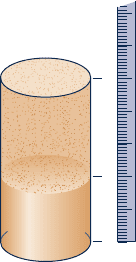
146 Chapter 3
Evaluating Properties
(b) the temperature at p 5 60 lbf/in.
2
, y 5 5.982 ft
3
/lb,
in °F.
(c) the specific volume at T 5 110°F, p 5 58 lbf/in.
2
, in ft
3
/lb.
3.9 Determine the volume change, in ft
3
, when 1 lb of water,
initially saturated liquid, is heated to saturated vapor while
pressure remains constant at 1.0, 14.7, 100, and 500, each in
lbf/in.
2
Comment.
3.10 For H
2
O, determine the specified property at the indicated
state. Locate the state on a sketch of the T–y diagram.
(a) p 5 300 kPa, y 5 0.5 m
3
/kg. Find T, in °C.
(b) p 5 28 MPa, T 5 200°C. Find y, in m
3
/kg.
(c) p 5 1 MPa, T 5 405°C. Find y, in m
3
/kg.
(d) T 5 100°C, x 5 60%. Find y, in m
3
/kg.
3.11 For each case, determine the specific volume at the
indicated state. Locate the state on a sketch of the T–y
diagram.
(a) Water at p 5 14.7 lbf/in.
2
, T 5 100°F. Find y, in ft
3
/lb.
(b) Ammonia at T 5 230°C, x 5 50%. Find y, in m
3
/kg.
(c) Refrigerant 134a at p 5 1.5 MPa, T 5 100°C. Find y,
in m
3
/kg.
3.12 For each case, determine the specified property at the
indicated state. Locate the state on a sketch of the T–y
diagram.
(a) Water at y 5 0.5 m
3
/kg, p 5 3 bar, determine T, in °C.
(b) Ammonia at p 5 11 lbf/in.
2
, T 5 220°F, determine y,
in ft
3
/lb.
(c) Propane at p 5 1 MPa, T 5 85°C, determine y, in m
3
/kg.
3.13 For H
2
O, determine the specific volume at the indicated
state, in m
3
/kg. Locate the states on a sketch of the T–y
diagram.
(a) T 5 400°C, p 5 20 MPa.
(b) T 5 40°C, p 5 20 MPa.
(c) T 5 40°C, p 5 2 MPa.
3.14 For H
2
O, locate each of the following states on sketches
of the p–y, T–y, and phase diagrams.
(a) T 5 120°C, p 5 5 bar.
(b) T 5 120°C, y 5 0.6 m
3
/kg.
(c) T 5 120°C, p 5 1 bar.
3.15 Complete the following exercises. In each case locate the
state on sketches of the T–y and p–y diagrams.
(a) Four kg of water at 100°C fill a closed container having
a volume of 1 m
3
. If the water at this state is a vapor,
determine the pressure, in bar. If the water is a two-phase
liquid–vapor mixture, determine the quality.
(b) Ammonia at a pressure of 40 lbf/in.
2
has a specific
internal energy of 308.75 Btu/lb. Determine the specific
volume at the state, in ft
3
/lb.
3.16 Two kg of a two-phase, liquid–vapor mixture of carbon
dioxide (CO
2
) exists at 240°C in a 0.05 m
3
tank. Determine
the quality of the mixture, if the values of specific volume
for saturated liquid and saturated vapor CO
2
at 240°C are
y
f
5 0.896 3 10
23
m
3
/kg and y
g
5 3.824 3 10
22
m
3
/kg,
respectively.
3.17 Each of the following exercises requires evaluating the
quality of a two-phase liquid–vapor mixture:
(a) The quality of a two-phase liquid–vapor mixture of H
2
O
at 40°C with a specific volume of 10 m
3
/kg is
(i) 0, (ii) 0.486 (iii) 0.512, (iv) 1.
(b) The quality of a two-phase liquid–vapor mixture of
propane at 20 bar with a specific internal energy of 300 kJ/kg
is (i) 0.166, (ii) 0.214, (iii) 0.575, (iv) 0.627.
(c) The quality of a two-phase liquid–vapor mixture of
Refrigerant 134a at 90 lbf/in.
2
with a specific enthalpy of
90 Btu/lb is (i) 0.387, (ii) 0.718, (iii) 0.806, (iv) 0.854.
(d) The quality of a two-phase liquid–vapor mixture of
ammonia at 220°F with a specific volume of 11 ft
3
/lb is
(i) 0, (ii) 0.251, (iii) 0.537, (iv) 0.749.
3.18 Determine the quality of a two-phase liquid–vapor
mixture of
(a) H
2
O at 10 lbf/in.
2
with a specific volume of 15 ft
3
/lb.
(b) Refrigerant 134a at 60°F with a specific internal energy
of 50.5 Btu/lb.
(c) ammonia at 80 lbf/in.
2
with a specific enthalpy of 350
Btu/lb.
(d) propane at 220°F with a specific volume of 1 ft
3
/lb.
3.19 A two-phase liquid–vapor mixture of ammonia has a
specific volume of 1.0 ft
3
/lb. Determine the quality if the
temperature is (a) 100°F, (b) 0°F. Locate the states on a
sketch of the T–y diagram.
3.20 A two-phase liquid–vapor mixture of a substance has a
pressure of 150 bar and occupies a volume of 0.2 m
3
. The
masses of saturated liquid and vapor present are 3.8 kg and
4.2 kg, respectively. Determine the specific volume of the
mixture, in m
3
/kg.
3.21 As shown in Fig. P3.21, a closed, rigid cylinder contains
different volumes of saturated liquid water and saturated
water vapor at a temperature of 150°C. Determine the
quality of the mixture, expressed as a percent.
Saturated
liquid
Saturated
vapor
T = 150°C
0
10
20
30
40
50
60
70
Fig. P3.21
3.22 As shown in Fig. P3.22, 0.1 kg of water is contained within
a piston–cylinder assembly at 100°C. The piston is free to
move smoothly in the cylinder. The local atmospheric
pressure and acceleration of gravity are 100 kPa and 9.81 m/s
2
,
respectively. For the water, determine the pressure, in kPa,
and volume, in cm
3
.
c03EvaluatingProperties.indd Page 146 5/27/10 8:26:38 AM user-f391 c03EvaluatingProperties.indd Page 146 5/27/10 8:26:38 AM user-f391 /Users/user-f391/Desktop/27MAY/Users/user-f391/Desktop/27MAY
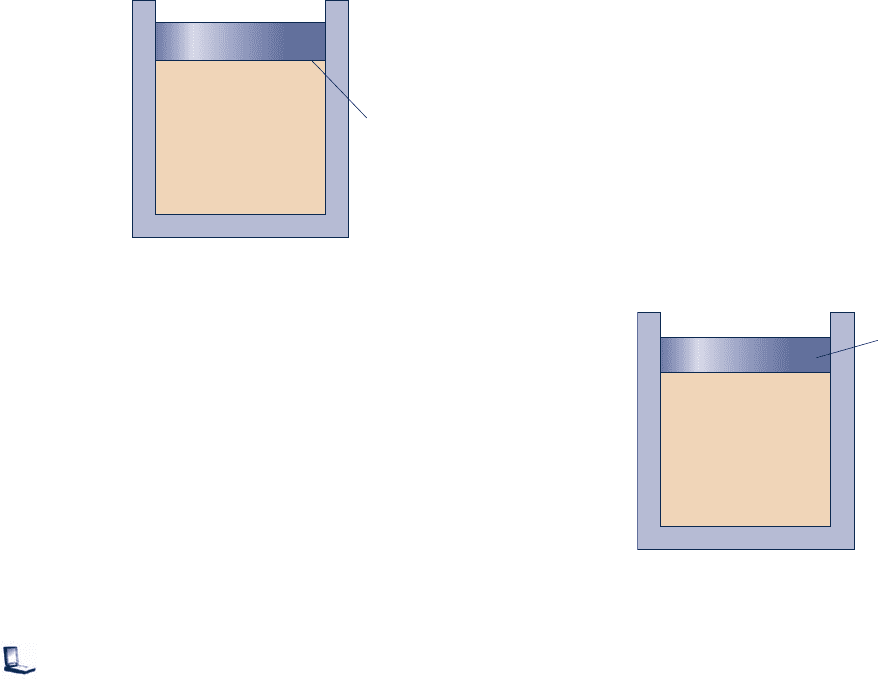
3.23 Ammonia, initially saturated vapor at 24°C, undergoes a
constant-specific volume process to 200 kPa. At the final
state, determine the temperature, in °C, and the quality.
Locate each state on a sketch of the T–y diagram.
3.24 Water contained in a closed, rigid tank, initially saturated
vapor at 200°C, is cooled to 100°C. Determine the initial and
final pressures, each in bar. Locate the initial and final states
on sketches of the p–y and T–y diagrams.
3.25 A closed, rigid tank whose volume is 1.5 m
3
contains
Refrigerant 134a, initially a two-phase liquid–vapor mixture at
10°C. The refrigerant is heated to a final state where temperature
is 50°C and quality is 100%. Locate the initial and final states
on a sketch of the T–y diagram. Determine the mass of vapor
present at the initial and final states, each in kg.
3.26 In each of the following cases, ammonia contained in a
closed, rigid tank is heated from an initial saturated vapor
state at temperature T
1
to the final temperature, T
2
:
(a) T
1
5 20°C, T
2
5 40°C. Using IT, determine the final
pressure, in bar.
(b) T
1
5 70°F, T
2
5 120°F. Using IT, determine the final
pressure, in lbf/in.
2
Compare the pressure values determined using IT with those
obtained using the appropriate Appendix tables for ammonia.
3.27 Propane is contained in a closed, rigid container with a
volume of 10 m
3
. Initially the pressure and temperature of
the propane are 8 bar and 80°C, respectively. The temperature
drops as a result of energy rejected by heat transfer to
the surroundings. Determine the temperature at which
condensation first occurs, in °C, and the fraction of the total
mass that has condensed when the pressure reaches 5 bar.
What is the volume, in m
3
, occupied by saturated liquid at
the final state?
3.28 Water vapor is cooled in a closed, rigid tank from 520°C
and 100 bar to a final temperature of 270°C. Determine the
final pressure, in bar, and sketch the process on T–y and
p–y diagrams.
3.29 Ammonia contained in a piston–cylinder assembly, initially
saturated vapor at 0°F, undergoes an isothermal process
during which its volume (a) doubles, (b) reduces by a half.
For each case, fix the final state by giving the quality or
pressure, in lbf/in.
2
, as appropriate. Locate the initial and
final states on sketches of the p–y and T–y diagrams.
3.30 One kg of water initially is at the critical point.
(a) If the water is cooled at constant-specific volume to a
pressure of 30 bar, determine the quality at the final state.
(b) If the water undergoes a constant-temperature expansion
to a pressure of 30 bar, determine the specific volume at the
final state, in m
3
/kg.
Show each process on a sketch of the T–y diagram.
3.31 As shown in Fig. P3.31, a cylinder fitted with a piston is
filled with 600 lb of saturated liquid ammonia at 45°F. The
piston weighs 1 ton and has a diameter of 2.5 ft. What is the
volume occupied by the ammonia, in ft
3
? Ignoring friction,
is it necessary to provide mechanical attachments, such as
stops, to hold the piston in place? Explain.
Piston
m = 50 kg
g = 9.81 m/s
2
p
atm
= 100 kPa
A = 0.01 m
2
Water
0.1 kg at 100°
C
Fig. P3.22
Ammonia
Saturated liquid
at 45°F
m = 600 lb
Piston
p
atm
= 1 atm
Weight = 1 ton
D
= 2.5 ft
Fig. P3.31
3.32 Two lb of water vapor in a piston–cylinder assembly is
compressed at a constant pressure of 250 lbf/in.
2
from a
volume of 6.88 ft
3
to a saturated vapor state. Determine the
temperatures at the initial and final states, each in °F, and
the work for the process, in Btu.
3.33 Seven lb of propane in a piston–cylinder assembly, initially
at p
1
5 200 lbf/in.
2
and T
1
5 200°F, undergoes a constant-
pressure process to a final state. The work for the process is
288.84 Btu. At the final state, determine the temperature, in
°F, if superheated, or the quality if saturated.
3.34 Ammonia in a piston–cylinder assembly undergoes a
constant-pressure process at 2.5 bar from T
1
5 30°C to
saturated vapor. Determine the work for the process, in kJ
per kg of refrigerant.
3.35 From an initial state where the pressure is p
1
, the
temperature is T
1
, and the volume is V
1
, water vapor
contained in a piston–cylinder assembly undergoes each of
the following processes:
Process 1–2: Constant-temperature to p
2
5 2p
1
.
Process 1–3: Constant-volume to p
3
5 2p
1
.
Process 1–4: Constant-pressure to V
4
5 2V
1
Process 1–5: Constant-temperature to V
5
5 2V
1
On a p–V diagram, sketch each process, identify the work by
an area on the diagram, and indicate whether the work is
done by, or on, the water vapor.
3.36 Three kilograms of Refrigerant 22 undergo a process for
which the pressure–specific volume relation is py
20.8
5 constant.
The initial state of the refrigerant is 12 bar and 60°C, and the
Problems: Developing Engineering Skills 147
c03EvaluatingProperties.indd Page 147 6/29/10 1:58:54 PM user-s146 c03EvaluatingProperties.indd Page 147 6/29/10 1:58:54 PM user-s146 /Users/user-s146/Desktop/Merry_X-Mas/New/Users/user-s146/Desktop/Merry_X-Mas/New

148 Chapter 3
Evaluating Properties
final pressure is 8 bar. Kinetic and potential energy effects
are negligible. Determine the work, in kJ, for the process.
3.37 As shown in Fig. P3.37, Refrigerant 134a is contained in a
piston–cylinder assembly, initially as saturated vapor. The
refrigerant is slowly heated until its temperature is 160°C.
During the process, the piston moves smoothly in the
cylinder. For the refrigerant, evaluate the work, in kJ/kg.
(a) At p 5 2 MPa, T 5 300°C. Find u, in kJ/kg.
(b) At p 5 2.5 MPa, T 5 200°C. Find u, in kJ/kg.
(c) At T 5 170 F, x 5 50%. Find u, in Btu/lb.
(d) At p 5 100 lbf/in.
2
, T 5 300°F. Find h, in Btu/lb
(e) At p 5 1.5 MPa, y 5 0.2095 m
3
/kg. Find h, in kJ/kg.
3.43 For each case, determine the specified property value and
locate the state by hand on sketches of the p–y and T–y
diagrams.
(a) For Refrigerant 134a at T 5 160°F, h 5 127.7 Btu/lb. Find
y, in ft
3
/lb.
(b) For Refrigerant 134a at T 5 90°F, u 5 72.71 Btu/lb. Find
h, in Btu/lb.
(c) For ammonia at T 5 160°F, p 5 60 lbf/in.
2
Find u, in
Btu/lb.
(d) For ammonia at T 5 0°F, p 5 35 lbf/in.
2
Find u, in Btu/lb.
(e) For Refrigerant 22 at p 5 350 lbf/in.
2
, T 5 350°F. Find u,
in Btu/lb.
3.44 Using the tables for water, determine the specified
property data at the indicated states. In each case, locate the
state by hand on sketches of the p–y and T–y diagrams.
(a) At p 5 3 bar, y 5 0.5 m
3
/kg, find T in °C and u in kJ/kg.
(b) At T 5 320°C, y 5 0.03 m
3
/kg, find p in MPa and u in
kJ/kg.
(c) At p 5 28 MPa, T 5 520°C, find y in m
3
/kg and h in
kJ/kg.
(d) At T 5 10°C, y 5 100 m
3
/kg, find p in kPa and h in kJ/kg.
(e) At p 5 4 MPa, T 5 160°C, find y in m
3
/kg and u in kJ/kg.
3.45 Using the tables for water, determine the specified
property data at the indicated states. In each case, locate the
state by hand on sketches of the p–y and T–y diagrams.
(a) At p 5 20 lbf/in.
2
, y 5 16 ft
3
/lb, find T in °F and u in
Btu/lb.
(b) At T 5 900°F, p 5 170 lbf/in.
2
, find y in ft
3
/lb and h in
Btu/lb.
(c) At T 5 600°F, y 5 0.6 ft
3
/lb, find p in lbf/in.
2
and u in
Btu/lb.
(d) At T 5 40°F, y 5 1950 ft
3
/lb, find p in lbf/in.
2
and h in
Btu/lb.
(e) At p 5 600 lbf/in.
2
, T 5 320°F, find y in ft
3
/lb and u in
Btu/lb.
3.46 For each case, determine the specified property data and
locate the state by hand on a sketch of the T–y diagram.
(a) Evaluate the specific volume, in ft
3
/lb, and the specific
enthalpy, in Btu/lb, of water at 400°F and a pressure of 3000
lbf/in.
2
(b) Evaluate the specific volume, in ft
3
/lb, and the specific
enthalpy, in Btu/lb, of Refrigerant 134a at 95°F and 150 lbf/in.
2
(c) Evaluate the specific volume, in m
3
/kg, and the specific
enthalpy, in kJ/kg, of ammonia at 20°C and 1.0 MPa.
(d) Evaluate the specific volume, in m
3
/kg, and the specific
enthalpy, in kJ/kg, of propane at 800 kPa and 0°C.
Applying the Energy Balance
3.47 Water, initially saturated vapor at 4 bar, fills a closed, rigid
container. The water is heated until its temperature is 400°C.
For the water, determine the heat transfer, in kJ/kg. Kinetic
and potential energy effects can be ignored.
Piston
p
atm
= 1 bar
Q
Initial: Saturated vapor
Final: T
2
= 160°C
Weight = 471.1 N
D
= 0.02 m
Refrigerant 134a
Fig. P3.37
3.38 A piston–cylinder assembly contains 0.1 lb of propane.
The propane expands from an initial state where p
1
5 60 lbf/in.
2
and T
1
5 30°F to a final state where p
2
5 10 lbf/in.
2
During
the process, the pressure and specific volume are related
by py
2
5 constant. Determine the energy transfer by work,
in Btu.
Using u–h Data
3.39 Determine the values of the specified properties at each
of the following conditions.
(a) For Refrigerant 134a at T 5 60°C and y 5 0.072 m
3
/kg,
determine p in kPa and h in kJ/kg.
(b) For ammonia at p 5 8 bar and y 5 0.005 m
3
/kg, determine
T in °C and u in kJ/kg.
(c) For Refrigerant 22 at T 5 210°C and u 5 200 kJ/kg,
determine p in bar and y in m
3
/kg.
3.40 Determine the values of the specified properties at each
of the following conditions.
(a) For Refrigerant 134a at p 5 140 lbf/in.
2
and h 5 100
Btu/lb, determine T in °F and y in ft
3
/lb.
(b) For ammonia at T 5 0°F and y 5 15 ft
3
/lb, determine p
in lbf/in.
2
and h in Btu/lb.
(c) For Refrigerant 22 at T 5 30°F and y 5 1.2 ft
3
/lb,
determine p in lbf/in.
2
and h in Btu/lb.
3.41 Using IT, determine the specified property data at the
indicated states. Compare with results from the appropriate
table.
(a) Cases (a), (b), and (c) of Problem 3.39.
(b) Cases (a), (b), and (c) of Problem 3.40.
3.42 Using the tables for water, determine the specified
property data at the indicated states. In each case, locate the
state by hand on sketches of the p–y and T–y diagrams.
c03EvaluatingProperties.indd Page 148 6/29/10 1:58:59 PM user-s146 c03EvaluatingProperties.indd Page 148 6/29/10 1:58:59 PM user-s146 /Users/user-s146/Desktop/Merry_X-Mas/New/Users/user-s146/Desktop/Merry_X-Mas/New
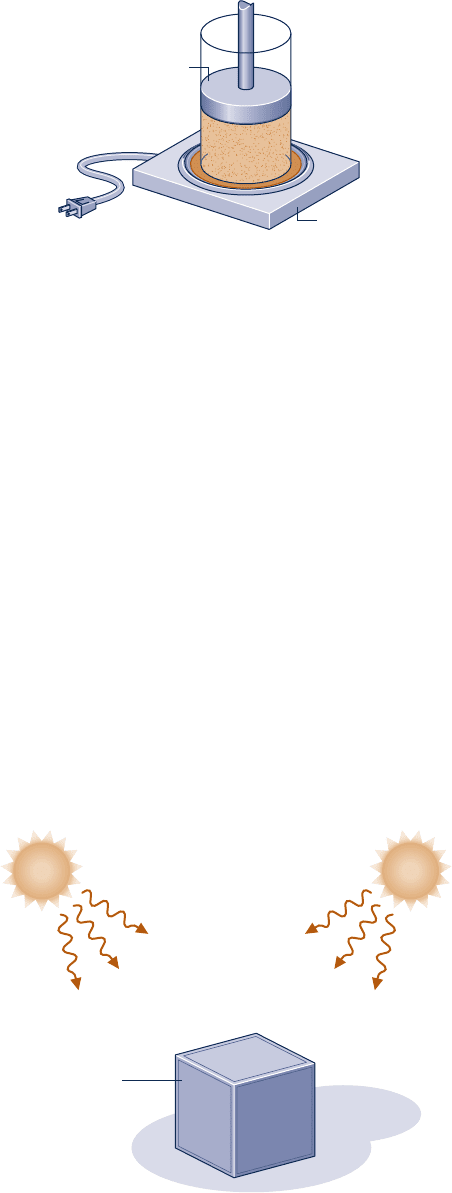
3.48 A closed, rigid tank contains Refrigerant 134a, initially at
100°C. The refrigerant is cooled until it becomes saturated
vapor at 20°C. For the refrigerant, determine the initial and
final pressures, each in bar, and the heat transfer, in kJ/kg.
Kinetic and potential energy effects can be ignored.
3.49 A closed, rigid tank is filled with water. Initially, the tank
holds 9.9 ft
3
saturated vapor and 0.1 ft
3
saturated liquid, each
at 212°F. The water is heated until the tank contains only
saturated vapor. For the water, determine (a) the quality at
the initial state, (b) the temperature at the final state, in °F,
and (c) the heat transfer, in Btu. Kinetic and potential energy
effects can be ignored.
3.50 A closed, rigid tank is filled with water, initially at the
critical point. The water is cooled until it attains a temperature
of 400°F. For the water, show the process on a sketch of
the T–y diagram and determine the heat transfer, in Btu/lb.
3.51 Propane within a piston–cylinder assembly undergoes a
constant-pressure process from saturated vapor at 400 kPa
to a temperature of 40°C. Kinetic and potential energy effects
are negligible. For the propane, (a) show the process on a
p–y diagram, (b) evaluate the work, in kJ/kg, and (c) evaluate
the heat transfer, in kJ/kg.
3.52 Refrigerant 134a expands in a piston–cylinder assembly
from 180 lbf/in.
2
and 140°F to 30 lbf/in.
2
The mass of
refrigerant is 0.5 lb. During the process, heat transfer to the
refrigerant from its surroundings is 1.2 Btu while the work
done by the refrigerant is 4.32 Btu. Determine the final
temperature of the refrigerant, in °F. Kinetic and potential
energy effects are negligible.
3.53 Ammonia vapor in a piston–cylinder assembly undergoes
a constant-pressure process from saturated vapor at 10 bar.
The work is 116.5 kJ/kg. Changes in kinetic and potential
energy are negligible. Determine (a) the final temperature
of the ammonia, in °C, and (b) the heat transfer, in kJ/kg.
3.54 Water in a piston–cylinder assembly, initially at a
temperature of 99.63°C and a quality of 65%, is heated at
constant pressure to a temperature of 200°C. If the work
during the process is 1300 kJ, determine (a) the mass of water,
in kg, and (b) the heat transfer, in kJ. Changes in kinetic and
potential energy are negligible.
3.55 A piston–cylinder assembly containing water, initially a
liquid at 50°F, undergoes a process at a constant pressure of
20 lbf/in.
2
to a final state where the water is a vapor at 300°F.
Kinetic and potential energy effects are negligible. Determine
the work and heat transfer, in Btu per lb, for each of three
parts of the overall process: (a) from the initial liquid state to
the saturated liquid state, (b) from saturated liquid to
saturated vapor, and (c) from saturated vapor to the final
vapor state, all at 20 lbf/in.
2
3.56 As shown in Fig. P3.56, 0.1 kg of propane is contained
within a piston-cylinder assembly at a constant pressure of
0.2 MPa. Energy transfer by heat occurs slowly to the
propane, and the volume of the propane increases from
0.0277 m
3
to 0.0307 m
3
. Friction between the piston and
cylinder is negligible. The local atmospheric pressure and
acceleration of gravity are 100 kPa and 9.81 m/s
2
, respectively.
The propane experiences no significant kinetic and potential
energy effects. For the propane, determine (a) the initial and
final temperatures, in °C, (b) the work, in kJ, and (c) the heat
transfer, in kJ.
Hot plate
+
–
Propane
Piston
m
p
V
1
V
2
= 0.1 kg
= 0.2 MPa
= 0.0277 m
3
= 0.0307 m
3
p
atm
= 100 kPa
Fig. P3.56
3.57 A piston–cylinder assembly contains water, initially saturated
liquid at 150°C. The water is heated at constant temperature
to saturated vapor.
(a) If the rate of heat transfer to the water is 2.28 kW,
determine the rate at which work is done by the water on
the piston, in kW.
(b) If in addition to the heat transfer rate given in part (a)
the total mass of water is 0.1 kg, determine the time, in s,
required to execute the process.
3.58 A closed, rigid tank contains 2 kg of water, initially a two-
phase liquid–vapor mixture at 80°C. Heat transfer occurs until
the tank contains only saturated vapor with y 5 2.045 m
3
/kg.
For the water, locate the initial and final states on a sketch of
the T–y diagram and determine the heat transfer, in kJ.
3.59 As shown in Fig. P3.59, a rigid, closed tank having a
volume of 20 ft
3
and filled with 75 lb of Refrigerant 134a is
exposed to the sun. At 9:00 a.m., the refrigerant is at a
pressure of 100 lbf/in.
2
By 3:00 p.m., owing to solar radiation,
the refrigerant is a saturated vapor at a pressure greater than
100 lbf/in.
2
For the refrigerant, determine (a) the initial
9:00 a.m.
3:00 p.m.
V = 20 ft
3
m
p
1
= 75 lb
= 100 lbf/in.
2
Refrigerant 134a
At 3:00 p.m., saturated
vapor at p
2
> 100 lbf/in.
2
At 9:00 a.m.,
Fig. P3.59
Problems: Developing Engineering Skills 149
c03EvaluatingProperties.indd Page 149 5/27/10 8:29:44 AM user-f391 c03EvaluatingProperties.indd Page 149 5/27/10 8:29:44 AM user-f391 /Users/user-f391/Desktop/27MAY/Users/user-f391/Desktop/27MAY

150 Chapter 3
Evaluating Properties
temperature, in °F, (b) the final pressure, in lbf/in.
2
, and
(c) the heat transfer, in Btu.
3.60 A rigid, insulated tank fitted with a paddle wheel is
filled with water, initially a two-phase liquid–vapor mixture
at 20 lbf/in.
2
, consisting of 0.07 lb of saturated liquid and
0.07 lb of saturated vapor. The tank contents are stirred by
the paddle wheel until all of the water is saturated vapor
at a pressure greater than 20 lbf/in.
2
Kinetic and potential
energy effects are negligible. For the water, determine
the
(a) volume occupied, in ft
3
.
(b) initial temperature, in °F.
(c) final pressure, in lbf/in.
2
(d) work, in Btu.
3.61 If the hot plate of Example 3.2 transfers energy at a rate
of 0.1 kW to the two-phase mixture, determine the time
required, in h, to bring the mixture from (a) state 1 to state
2, (b) state 1 to state 3.
3.62 A closed, rigid tank filled with water, initially at 20 bar, a
quality of 80%, and a volume of 0.5 m
3
, is cooled until the
pressure is 4 bar. Show the process of the water on a sketch
of the T–y diagram and evaluate the heat transfer, in kJ.
3.63 As shown in Fig. P3.63, a closed, rigid tank fitted with a
fine-wire electric resistor is filled with Refrigerant 22, initially
at 210°C, a quality of 80%, and a volume of 0.01 m
3
. A
12-volt battery provides a 5-amp current to the resistor for
5 minutes. If the final temperature of the refrigerant is 40°C,
determine the heat transfer, in kJ, from the refrigerant.
3.64 A rigid, well-insulated tank contains a two-phase mixture
of ammonia with 0.0025 ft
3
of saturated liquid and 1.5 ft
3
of
saturated vapor, initially at 40 lbf/in.
2
A paddle wheel stirs
the mixture until only saturated vapor at higher pressure
remains in the tank. Kinetic and potential energy effects are
negligible. For the ammonia, determine the amount of energy
transfer by work, in Btu.
3.65 A closed, rigid tank is filled with 0.02 lb of water, initially
at 120°F and a quality of 50%. The water receives 8 Btu by
heat transfer. Determine the temperature, in °F, pressure, in
lbf/in.
2
, and quality of the water at its final state.
3.66 A piston–cylinder assembly contains ammonia, initially at
a temperature of 220°C and a quality of 50%. The ammonia
is slowly heated to a final state where the pressure is 6 bar
and the temperature is 180°C. While the ammonia is heated,
its pressure varies linearly with specific volume. Show the
process of the ammonia on a sketch of the p–y diagram. For
the ammonia, determine the work and heat transfer, each
in kJ/kg.
3.67 A rigid, well-insulated container with a volume of 2 ft
3
holds 0.12 lb of ammonia initially at a pressure of 20 lbf/in.
2
The ammonia is stirred by a paddle wheel, resulting in an
energy transfer to the ammonia with a magnitude of 1 Btu.
For the ammonia, determine the initial and final temperatures,
each in °R, and the final pressure, in lbf/in.
2
Neglect kinetic
and potential energy effects.
3.68 Water contained in a piston–cylinder assembly, initially at
300°F, a quality of 90%, and a volume of 6 ft
3
, is heated at
constant temperature to saturated vapor. If the rate of heat
transfer is 0.3 Btu/s, determine the time, in min, for this
process of the water to occur. Kinetic and potential energy
effects are negligible.
3.69 Five kg of water is contained in a piston–cylinder assembly,
initially at 5 bar and 240°C. The water is slowly heated at
constant pressure to a final state. If the heat transfer for the
process is 2960 kJ, determine the temperature at the final
state, in °C, and the work, in kJ. Kinetic and potential energy
effects are negligible.
3.70 Referring to Fig. P3.70, water contained in a piston–
cylinder assembly, initially at 1.5 bar and a quality of 20%,
is heated at constant pressure until the piston hits the stops.
Heating then continues until the water is saturated vapor.
Show the processes of the water in series on a sketch of the
T–y diagram. For the overall process of the water, evaluate
the work and heat transfer, each in kJ/kg. Kinetic and
potential effects are negligible.
3.71 A piston–cylinder assembly contains 2 lb of water, initially
at 300°F. The water undergoes two processes in series:
constant-volume heating followed by a constant-pressure
process. At the end of the constant-volume process, the
pressure is 100 lbf/in.
2
and the water is a two-phase, liquid–
vapor mixture with a quality of 80%. At the end of the
constant-pressure process, the temperature is 400°F. Neglect
kinetic and potential energy effects.
(a) Sketch T–y and p–y diagrams showing key states and the
processes.
(b) Determine the work and heat transfer for each of the
two processes, all in Btu.
Resistor
12-volt battery provides a
5-amp current for
5 minutes.
Refrigerant 22
T
1
= ⫺10°C
x
1
= 80%
T
2
= 40°C
V = 0.01 m
3
Fig. P3.63
c03EvaluatingProperties.indd Page 150 9/27/10 5:19:32 PM user-s146 c03EvaluatingProperties.indd Page 150 9/27/10 5:19:32 PM user-s146 /Users/user-s146/Desktop/Merry_X-Mas/New/Users/user-s146/Desktop/Merry_X-Mas/New
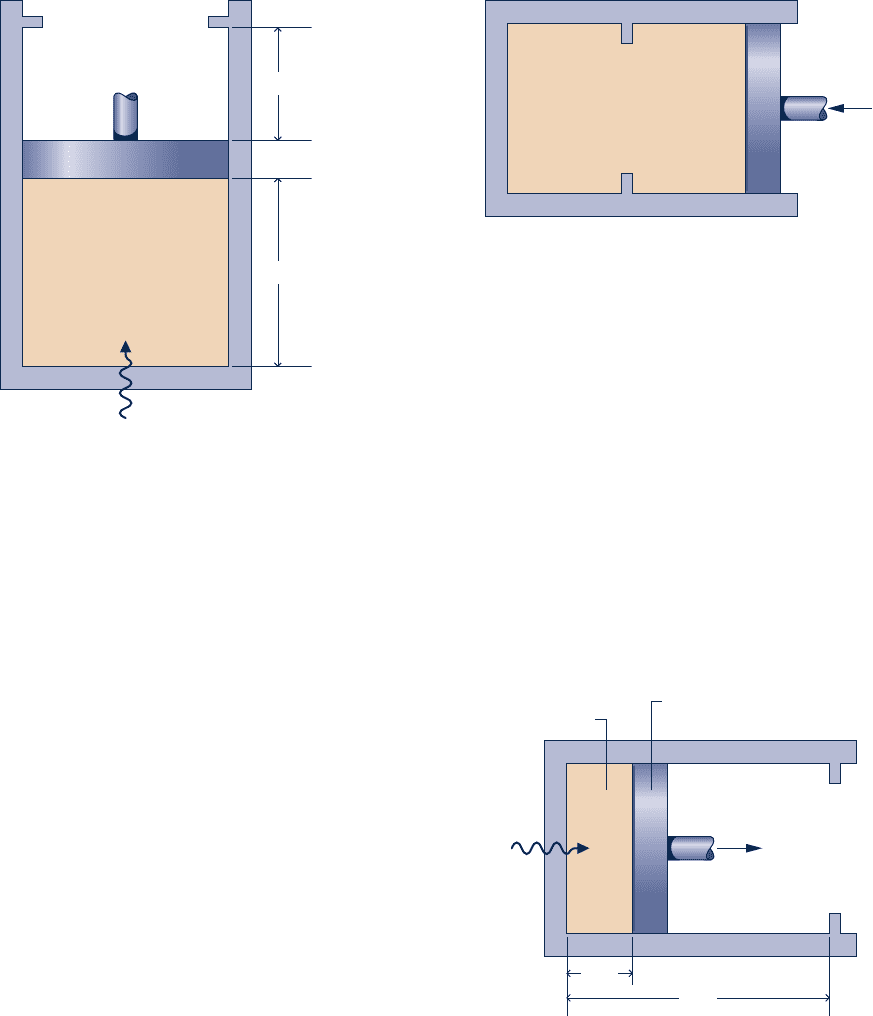
3.72 A system consisting of 3 lb of water vapor in a piston–
cylinder assembly, initially at 350°F and a volume of 71.7 ft
3
,
is expanded in a constant-pressure process to a volume of
85.38 ft
3
. The system then is compressed isothermally to a final
volume of 28.2 ft
3
. During the isothermal compression, energy
transfer by work into the system is 72 Btu. Kinetic and
potential energy effects are negligible. Determine the heat
transfer, in Btu, for each process.
3.73 Ammonia in a piston–cylinder assembly undergoes two
processes in series. Initially, the ammonia is saturated vapor at
p
1
5 100 lbf/in.
2
Process 1–2 involves cooling at constant
pressure until x
2
5 75%. The second process, from state 2 to
state 3, involves heating at constant volume until x
3
5 100%.
Kinetic and potential energy effects are negligible. For 1.2 lb of
ammonia, determine (a) the heat transfer and work for Process
1–2 and (b) the heat transfer for Process 2–3, all in Btu.
3.74 Three lb of water is contained in a piston–cylinder assembly,
initially occupying a volume V
1
5 30 ft
3
at T
1
5 300°F. The
water undergoes two processes in series:
Process 1–2: Constant-temperature compression to V
2
5 11.19 ft
3
,
during which there is an energy transfer by heat from the
water of 1275 Btu.
Process 2–3: Constant-volume heating to p
3
5 120 lbf/in.
2
Sketch the two processes in series on a T–y diagram.
Neglecting kinetic and potential energy effects, determine
the work in Process 1–2 and the heat transfer in Process
2–3, each in Btu.
3.75 As shown in Fig. P3.75, a piston-cylinder assembly fitted
with stops contains 0.1 kg of water, initially at 1 MPa, 500°C.
The water undergoes two processes in series:
Process 1–2: Constant-pressure cooling until the piston face
rests against the stops. The volume occupied by the water is
then one-half its initial volume.
Process 2–3: With the piston face resting against the stops, the
water cools to 25°C.
Sketch the two processes in series on a p–y diagram.
Neglecting kinetic and potential energy effects, evaluate for
each process the work and heat transfer, each in kJ.
3.76 A two-phase, liquid–vapor mixture of H
2
O, initially at
x 5 30% and a pressure of 100 kPa, is contained in a piston–
cylinder assembly, as shown in Fig P3.76. The mass of the
piston is 10 kg, and its diameter is 15 cm. The pressure of
the surroundings is 100 kPa. As the water is heated, the
pressure inside the cylinder remains constant until the piston
hits the stops. Heat transfer to the water continues at constant
volume until the pressure is 150 kPa. Friction between the
piston and the cylinder wall and kinetic and potential energy
effects are negligible. For the overall process of the water,
determine the work and heat transfer, each in kJ.
Water
p
1
= 1.5 bar
x
1
= 20%
0.05 m
Q
0.03 m
p
atm
= 1 bar
Piston
Fig. P3.70
0.1 kg of water,
initially at 1 MPa, 500°C.
Final temperature is 25°C.
Fig. P3.75
Water,
initially at
x = 30%,
p = 100 kPa
Piston
D = 15 cm
m = 10 kg
8 cm
2 cm
Q
p
atm
= 100 kPa
Fig. P3.76
3.77 A system consisting of 1 kg of H
2
O undergoes a power
cycle composed of the following processes:
Process 1–2: Constant-pressure heating at 10 bar from saturated
vapor.
Process 2–3: Constant-volume cooling to p
3
5 5 bar, T
3
5 160°C.
Process 3–4: Isothermal compression with Q
34
5 2815.8 kJ.
Process 4–1: Constant-volume heating.
Sketch the cycle on T–y and p–y diagrams. Neglecting kinetic
and potential energy effects, determine the thermal efficiency.
Problems: Developing Engineering Skills 151
c03EvaluatingProperties.indd Page 151 5/27/10 8:33:54 AM user-f391 c03EvaluatingProperties.indd Page 151 5/27/10 8:33:54 AM user-f391 /Users/user-f391/Desktop/27MAY/Users/user-f391/Desktop/27MAY
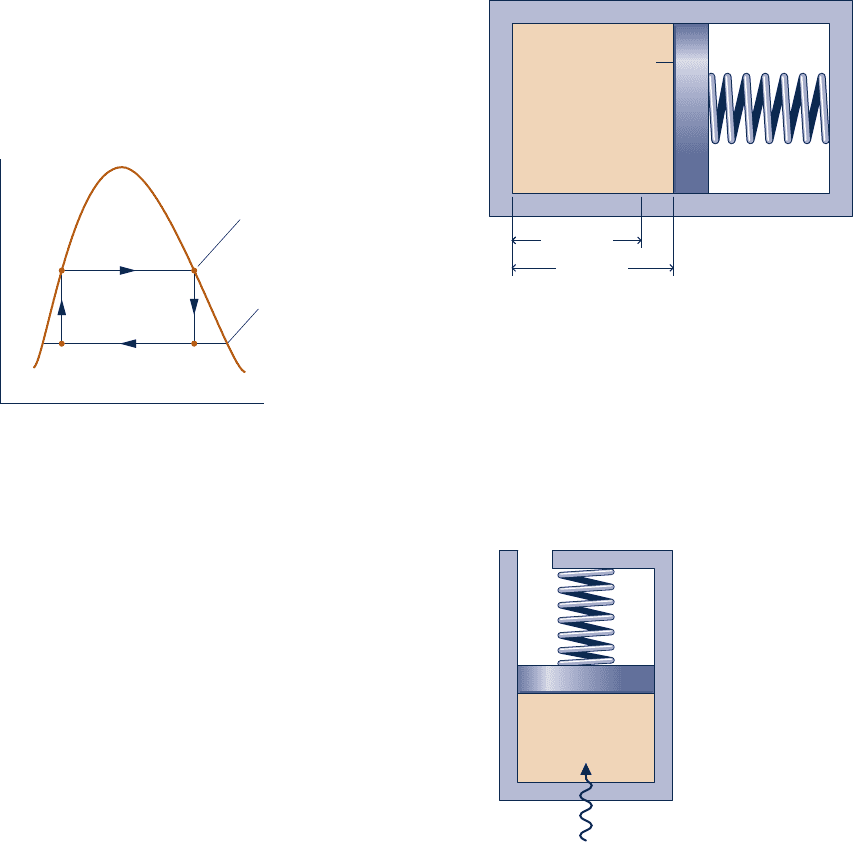
152 Chapter 3
Evaluating Properties
3.78 One lb of water contained in a piston–cylinder assembly
undergoes the power cycle shown in Fig. P3.78. For each of
the four processes, evaluate the work and heat transfer,
each in Btu. For the overall cycle, evaluate the thermal
efficiency.
3.84 As shown in Fig. P3.84, 0.5 kg of ammonia is contained
in a piston–cylinder assembly, initially at T
1
5 220°C and a
quality of 25%. As the ammonia is slowly heated to a final
state, where T
2
5 20°C, p
2
5 0.6 MPa, its pressure varies
linearly with specific volume. There are no significant kinetic
and potential energy effects. For the ammonia, (a) show the
process on a sketch of the p–y diagram and (b) evaluate the
work and heat transfer, each in kJ.
v
4
= v
1
T
v
v
3
= v
2
700 lbf/in.
2
70 lbf/in.
2
1
43
2
Fig. P3.78
3.79 One-half kg of Refrigerant-22 is contained in a piston–
cylinder assembly, initially saturated vapor at 5 bar. The
refrigerant undergoes a process for which the pressure-
specific volume relation is py 5 constant to a final pressure
of 20 bar. Kinetic and potential energy effects can be
neglected. Determine the work and heat transfer for the
process, each in kJ.
3.80 Ten kilograms of Refrigerant 22 contained in a piston–
cylinder assembly undergoes a process for which the pressure-
specific volume relationship is py
n
5 constant. The initial and
final states of the refrigerant are fixed by p
1
5 400 kPa, T
1
5
25°C, and p
2
5 2000 kPa, T
2
5 70°C, respectively. Determine
the work and heat transfer for the process, each in kJ.
3.81 A piston–cylinder assembly contains ammonia, initially at
0.8 bar and 210°C. The ammonia is compressed to a pressure
of 5.5 bar. During the process, the pressure and specific
volume are related by py 5 constant. For 20 kg of ammonia,
determine the work and heat transfer, each in kJ.
3.82 A piston–cylinder assembly contains propane, initially at
27°C, 1 bar, and a volume of 0.2 m
3
. The propane undergoes
a process to a final pressure of 4 bar, during which the
pressure–volume relationship is pV
1.1
5 constant. For the
propane, evaluate the work and heat transfer, each in kJ.
Kinetic and potential energy effects can be ignored.
3.83 Figure P3.83 shows a piston–cylinder assembly fitted with
a spring. The cylinder contains water, initially at 1000°F, and
the spring is in a vacuum. The piston face, which has an area
of 20 in.
2
, is initially at x
1
5 20 in. The water is cooled until
the piston face is at x
2
5 16 in. The force exerted by the
spring varies linearly with x according to F
spring
5 kx, where
k 5 200 lbf/in. Friction between the piston and cylinder is
negligible. For the water, determine
(a) the initial and final pressures, each in lbf/in.
2
(b) the amount of water present, in lb.
(c) the work, in Btu.
(d) the heat transfer, in Btu.
Water, initially
at 1000°F.
Vacuum
Area = 20 in.
2
x
1
= 20 in.
x
2
= 16 in.
F
spring
= kx
Fig. P3.83
Ammonia
Initially,
T
1
= –20°C, x = 25%
Finally,
T
2
= 20°C, p
2
= 0.6 MPa
m = 0.5 kg
Q
Fig. P3.84
3.85 A gallon of milk at 68°F is placed in a refrigerator. If
energy is removed from the milk by heat transfer at a
constant rate of 0.08 Btu/s, how long would it take, in minutes,
for the milk to cool to 40°F? The specific heat and density
of the milk are 0.94 Btu/lb ? °R and 64 lb/ft
3
, respectively.
3.86 Shown in Fig. P3.86 is an insulated copper block that
receives energy at a rate of 100 W from an embedded resistor.
If the block has a volume of 10
23
m
3
and an initial temperature
of 20°C, how long would it take, in minutes, for the temperature
to reach 60°C? Data for copper are provided in Table A-19.
3.87 In a heat-treating process, a 1-kg metal part, initially at
1075 K, is quenched in a closed tank containing 100 kg of
water, initially at 295 K. There is negligible heat transfer
between the contents of the tank and their surroundings.
Modeling the metal part and water as incompressible with
constant specific heats 0.5 kJ/kg ? K and 4.4 kJ/kg ? K,
respectively, determine the final equilibrium temperature
after quenching, in K.
c03EvaluatingProperties.indd Page 152 5/27/10 8:34:53 AM user-f391 c03EvaluatingProperties.indd Page 152 5/27/10 8:34:53 AM user-f391 /Users/user-f391/Desktop/27MAY/Users/user-f391/Desktop/27MAY
